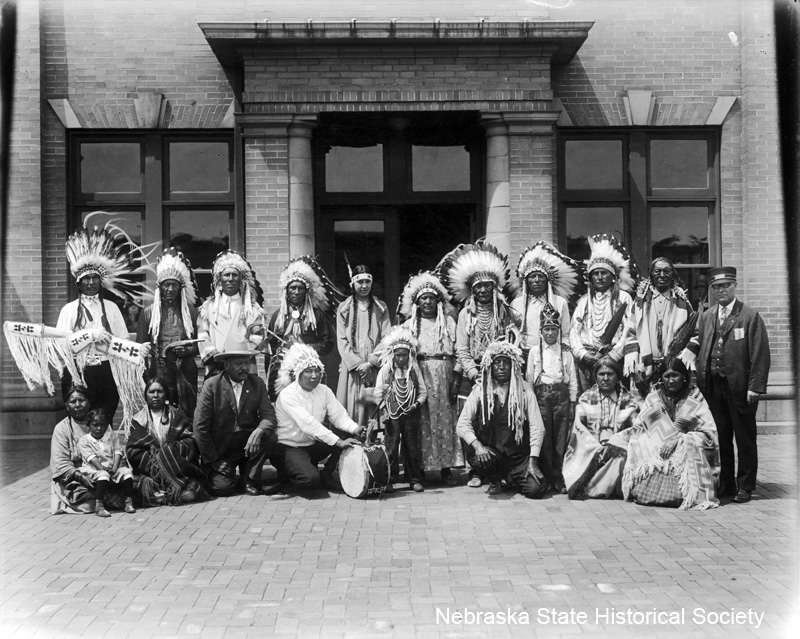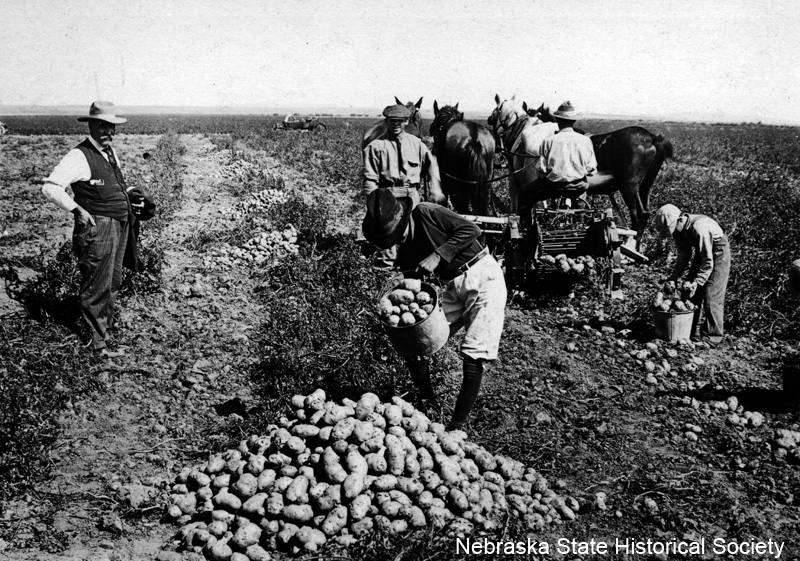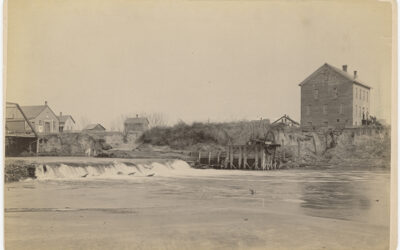 Dressed for a post-harvest dance, Lakotas pose at the Burlington depot in Alliance in the 1930s. RG2063-50-1
Dressed for a post-harvest dance, Lakotas pose at the Burlington depot in Alliance in the 1930s. RG2063-50-1
Note: the word Indian is used instead of Native American as it was the norm at the time.
A labor shortage during World War I left western Nebraska potato farmers facing the loss of their crop. They brought in Lakota (Sioux) Indians as harvesters, beginning a tradition that lasted from 1917 through the 1950s. The story is one both of prejudice and understanding, cooperation and conflict—and of long-lasting relationships forged by economic necessity. David R. Christensen writes about it in “‘I Don’t Know What We’d Have Done Without the Indians’: Non-Indian and Lakota Racial Relationships in Box Butte County’s Potato Industry, 1917-1960.” The article appears in the Fall 2011 issue of Nebraska History.
As the sun rose behind the Sandhills, illuminating the sky to a reddish-orange tint, a Lakota family emerged from their white canvas tent ready for the day’s potato harvest. Two Lakota men and women crossed the farmyard to the corral, where they helped the farmer hitch horses to wagons and to the potato digger. An elderly Lakota woman remained in the tent, brewing coffee and looking after the children-who were already scurrying about the farmyard playing “cowboys and Indians.” A dusting of frost on the grass, dirt, and equipment signaled the need to finish the harvest before a hard freeze ruined the potatoes. The Lakota women’s feet felt the sting of the morning chill through their moccasins. With the horses hitched, the farmer, his sons, and the Lakotas left for the potato fields to finish the harvest. En route, the sons and Lakotas engaged in a friendly conversation and wager regarding which group would pick the most potatoes-even though the Lakotas always won. Such a scene occurred annually on almost every farm in Box Butte County, Nebraska, during the first half of the twentieth century. Although anti-Indian prejudice was always present, the potato industry improved racial relationships between Lakotas and non-Indians, even resulting in enduring friendships.

A potato cellar in Box Butte County, 1917. Potatoes had to be picked and stored before the first hard freeze, which would spoil any unharvested potatoes. The western Nebraska potato industry developed in the early twentieth century, but had largely faded by the 1960s. RG3152-3-17
At the edge of the Sandhills, Box Butte County is located in the center of the Nebraska Panhandle. Today the county has only two incorporated towns: Alliance, the county seat, and Hemingford, eighteen miles away. In the 1910s expansion of the county’s potato production created a need for migrant labor. Until about 1960 Lakotas from the Pine Ridge and Rosebud Reservations in South Dakota came to work the potato harvest. Before the 1930s both farmers and other non-Indian county residents mostly treated the Lakotas well, grateful that their labor saved the potatoes from rotting in the fields. Likewise, the Lakotas were pleased to have jobs where they were paid, fairly treated, and appreciated by non-Indians. Although migrant labor exposed non-Indians to Lakota culture and initially helped dispel mutual stereotypes, racism and prejudice eventually soured relations between the two groups. During the Great Depression and World War II, the once welcoming communities in Box Butte County expressed anti-Lakota sentiments. Many farmers who hired the same Lakota families for decades rejected the towns’ prejudice; still, relationships between farmers and Lakotas were susceptible to the fluidity of the potato market. Periods of drought, depression, crop disease, and low potato prices resulted in low wages, which at times combined with alcohol-related problems to strain relationships. Scholars have revealed that migrant labor was essential to the late nineteenth and early twentieth century expansion of western extractive industries. American Indians used wage labor as a means of subsistence and community building, oftentimes entering and leaving wage labor at their own discretion. Many different systems of labor emerged, but Native peoples relied on their vast kinship networks for support, and strengthened their cultural identities while creating non-reservation Indian communities. Building on this scholarly framework, I will argue here that social relationships between non-Indians and Lakotas are a crucial and neglected part of interracial dynamics in western Nebraska. The poor race relations between Lakotas and western Nebraska residents are well known. Lakota scholar Vine Deloria, Jr., referred to Alliance as “a town almost as notoriously anti-Indian as Gordon [Nebraska].” Even so, emphasizing racial tension overlooks cases of racial understanding and cooperation, and misses the complexity of Lakota and non-Indian relationships forged during the early twentieth century potato harvests. Settlers of Box Butte County in the 1890s soon discovered its agricultural potential, and in the early 1900s local farmers began to see potatoes’ promise as a cash crop. Western Nebraska’s altitude-3,500 to 5,000 feet-results in lower temperatures essential for greater tuber growth. Its sandy soil improves the development of a tuber’s size and shape. Cool nights, light rainfall, and few insects make for ideal conditions.
A 1914 Alliance Commercial Club pamphlet praised the potato crop’s reliability and profitability. In 1915 work started on large warehouses in Alliance, Hemingford, and Marsland (a town northwest of Hemingford along the Niobrara River). The warehouses would protect the crop from frost while farmers waited to ship during peak prices. Demand for tubers grew in the East, and the Chicago-based Albert Miller & Co. contracted 100,000 bushels of potatoes for 1916. Potatoes quickly became a profitable investment. In 1915 seven acres of potatoes produced 1,232 bushels valued at $520.72, a $74.40 per-acre average. According to the Alliance Semi-Weekly Times, in 1916 farms in the county earned an average of $1,250 each from potatoes alone. E. I. Gregg, a farmer outside of Alliance, had forty acres in potatoes and received $3,000; another grower received $5,000 on forty acres. The average amount planted in tubers was twenty-five acres, yielding 150 bushels per acre. Moreover, with numerous acres of undeveloped prairie, Box Butte County’s potato industry had room to grow.

Harvesting southeast of Alliance. Digging potatoes was notoriously hard work. Many Lakota workers (not shown here) picked 100 to 150 bushels a day. An excellent picker could pick up to 200 bushels or more in a day. RG1431-8-24




